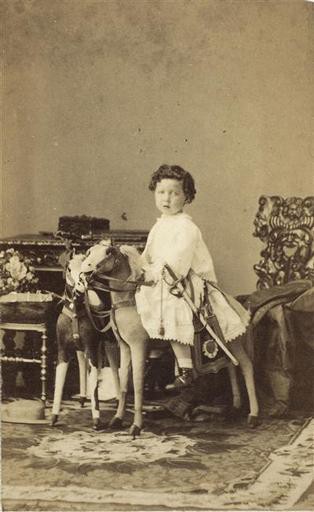Toys: a luxury…
During the Second Empire, toys were still on the whole considered a rare and expensive luxury available only to the richest of families. These toys were very expensive to make because they were still being made by hand. However, toys such as flutes, small trumpets and pinwheels were cheaper to produce and could thus offer children from poorer families hours of fun.
There were not many toys in the countryside either, and children would often make their own playthings from bits of wood, straw, rags and other objects found about the house. In the towns and cities, toys were generally sold in specialist toy shops such as the famous “Le Nain Bleu” (“The Blue Dwarf”), but they could also be found on the shelves of the early department stores in Paris.
Toys for boys
Just as they do today, little boys liked to imitate adults with their war games and they used swords, wooden lances and little lead soldiers to fight out the battles of Napoleon III and Napoleon Bonaparte’s glorious Grande Armée. Boys, much like the Prince Imperial – Napoleon III’s son – also amused themselves with their rocking and toy horses, skittles, building bricks and little drums. These toys are still popular today.
The doll, the queen of toys for girls
The most popular toy for little girls was the doll. These dolls were generally in adult form, with adult faces. Extremely pretty, the dolls were always perfectly presented, with their hair in golden curls, make-up and beautiful dresses which reflected the latest fashion. The most elegant of these dolls were known as “Parisians”. They were however extremely fragile, as the face, arms and legs were often made from porcelain or wax. The body was usually made from leather, wood or “gutta-percha” (an early form of latex). In Sophie Rostopchine’s book, Sophie’s Misfortunes, an unfortunate mishap befalls the wax doll: it melts in the sun after Sophie ignores the advice of her mother.
Just like real people, these dolls also came with different outfits, hats and accessories. A special magazine – La Poupée (The Doll) – was available to keep little girls informed regarding the latest developments: “Dolls and their outfits in the latest fashions, and such outfits! Silk and velvet dresses, real cashmere from India, fur, stitched satin hats, individually-laced or buttoned riding boots, jewels, bracelets, necklaces, fans, purses…” (La Poupée, December 1863). As well as these beautiful adult dolls, the baby doll appeared during this period. One of the most notable companies producing them was Petitcollin, which still exists today, one hundred and fifty years later! These dolls allowed girls to identify with their toys and finally enjoy children’s games rather than more adult-themed activities.
A doll’s tea party
For a little girl, playing with a doll involved choosing the outfit most appropriate for the task at hand. After all, a doll pursued exactly the same activities as a real person! Tea parties were frequent events, with the tea served and sipped from beautiful tea services, accurate miniature replicas of the larger scale Chinese porcelain services of the period.
Outdoor games
Children were not just confined to their own homes though: their nannies would frequently take them to the park. There, they could run around with their outdoor toys, such as the hoop. The child would propel this large ring – made from metal or wood – along using a stick. Older (and richer) children could also ride their tricycle, which started to become popular around this time. Little boys also liked to float their model sailboats on the park lakes and ponds.
During the Second Empire, the seaside became a popular holiday destination, made possible by advances in railway technology. On the beach, children – who were not yet allowed to swim in the sea – could play with their spades, rakes, balls and kites.
So toys during the Second Empire were not that different to those enjoyed today. The biggest difference? Teddy bears still did not exist yet!
Emmanuelle Papot (tr. H.D.W.)
Images
Image 1: a print of the Prince Imperial’s play room in Compiègne.
Image 2: dolls and their accessories during the Second Empire.
Image 3: a little girl with her dolly, 1865. Photograph taken by Achille Bonnenuit.
Image 4: a tea service from the Second Empire.
Image 5: going for a stroll in the Tuileries garden, 1855. Painting by Knaus Ludwig.


